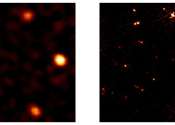Galaxy NGC 4696 hosts a complex globular cluster system, observations find
Using the Magellan Telescopes in Chile, astronomers have performed photometric observations of a giant elliptical galaxy known as NGC 4696. The observations reveal that the galaxy has a complex globular cluster system. The ...








